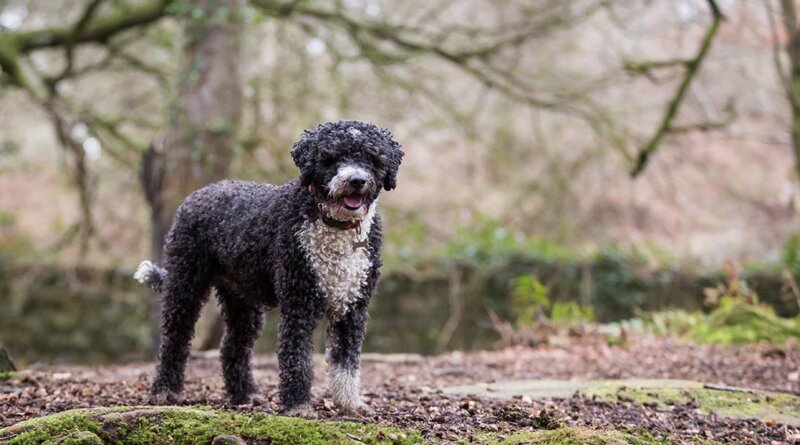Spanish Water Dog Breed Profile – Top Dog Tips
This blog will discuss everything you need about the Spanish Water Dog.
The Spanish Water Dog Breed is a medium-sized dog that is strong, muscular, and ready to work.
These dogs are loyal and intelligent pets. They are happy living an active lifestyle.
So if you’re the type of person who loves going on adventures, the Spanish Water Dog is the one for you.
They can adapt quickly to different environments and situations.
The breed has plenty of names! They are also known as Perro de Agua Español, Turco Andaluz, Perro Turco, or Andalucian Turk.
If you plan to adopt a Spanish Water Dog Puppy, scroll down as we discuss the dog’s temperament, training, exercise, grooming, and more!
But before that, let’s first tackle the dog’s history and origin.
Spanish Water Dog History
Although the Spanish Water Dog’s origins are unclear, many believe it is an ancient breed that originated in Spain.
It is thought to be related to other ancient water breeds, such as the Portuguese Water Dog and the Barbet.
These dogs have been known around Europe for several thousands of years.
Spanish Water Dogs were primarily used as working dogs.
They have served many purposes, such as hauling in fishing nets, retrieving items overboard, and herding sheep and goats.
In the 1970s, Spanish enthusiasts worked to revive the breed, which had nearly disappeared due to the decline of traditional fishing and farming practices in Spain.
They started a breeding program to standardize the breed and boost its working abilities.
In 1985, the Spanish Kennel Club officially recognized the Spanish Water Dog, and the American Kennel Club recognized the breed in 2015.
Spanish Water Dog’s Physical Traits
Now, let’s check out the Spanish Water Dog’s physical appearance.
The average height for Spanish Water Dogs is 15 to 20 inches at the shoulder, and they weigh an average of 30 to 50 pounds.
On the other hand, female Spanish Water Dogs are usually a little bit smaller than male ones.
The Spanish Water Dog Breed has a single coat with a woolly and curly texture.
Their coat comes in single or two colors from beige, beige and white, black and white, brown, brown and white, and white. They may also have some tan points in their coat.
The Spanish Water Dog’s head is medium-sized, with a slightly rounded skull and a well-defined stop.
The muzzle is short and wide, with strong jaws and a black or brown nose.
The Spanish Water Dog’s eyes are slanted and may be dark chestnut to hazel, and their nose in the shade of black or brown.
The Spanish Water Dog has well-developed and muscular fore and hind legs.
The Temperament of a Spanish Water Dog
Full of energy and love, that’s the Spanish Water Dog for you!
This curly woolly is fun and loving to be with. Let’s see what temperament Spanish Water Dogs have!
Spanish Water Dogs are extremely affectionate dogs. They’re playful and would love to spend their time with their family.
They’re the type of dogs that want to be part of everything their owners do.
Spanish Water Dogs can be left for a few hours, but it’s best not to, as they can become easily bored, stressed, and destructive.
If owners can leave them with someone else to dog-sit while they’re away, it’s best to do this option instead.
Although Spanish Water Dogs can adapt well, they may need some time to do so.
Introducing them to new things, places, people, and other pets can be a good experience for them as long as it is not sudden and forced.
That’s why early and constant socialization is essential for Spanish Water Dogs.
Sadly, the Spanish Water Dog isn’t the best choice for new–owners. They’re best homed to experienced owners.
But if new owners are determined to adopt a Spanish Water Dog, they must understand, prepare and train themselves and what may come.
ALSO READ: 10 Best Dog Breeds for First-Time Owners
Living with a Spanish Water Dog
Supervision is indeed needed for children as they also have a strong urge to herd them. Owners may teach their children how to interact with dogs properly to avoid accidents.
Spanish Water Dogs tend to be protective when it comes to the safety of their family.
They may open up to strangers after some introductions, but they’ll easily welcome them if they visit often.
Spanish Water Dogs are best in homes with fields or large backyards. Since they may have a sprout of energy, they must release it occasionally.
As long as they’re getting their exercise and training, they should do well with big homes.
Training & Exercise
It’s a must for Spanish Water Dogs to be stimulated physically and mentally every day as much as possible.
Spanish Water Dogs are extremely intelligent and active.
They learn quite easily and adapt to changes quickly as well. The difficult part to retain is their focus and their obedience.
Spanish Water Dogs should receive training while they’re still pups and should be continuous even when they’re adults.
They respond well to positive reinforcement training, just like most dogs.
Spanish Water Dogs can be easily discouraged if treated poorly or harshly. Owners may use sound conditioning or positive reinforcement when training.
The Spanish Water Dogs are very active. Owners may use this energy level and redirect it with exercise or playtime.
Since this breed is a natural utility dog, they can herd, and moving around is effortless.
With this, owners can teach their dogs some tricks or even give them a particular job every day.
The Spanish Water Dog will surely love to be a lending paw to you.
For exercising, Spanish Water Dogs must walk at least an hour daily. This can be divided into 30-minute walks twice a day.
To make exercising exciting, a run in an open field, a hike, a trek, catch, or other outdoor activities can also be done.
Owners can make varied exercises routine or have their Spanish Water Dog join them during outings as well.
Just ensure it is not overly strenuous and they get enough water and rest between activities.
Spanish Water Dog Health Care
Generally, the Spanish Water Dog is a healthy dog breed. Their life expectancy is about 10 to 14 years!
Unfortunately, like any other breed, the Spanish Water Dog can be prone to some diseases.
Owners should schedule regular visits to the veterinarian to keep their health in check.
Allergies
Although it’s uncommon for Spanish Water Dogs, some have allergies.
Owners should also ask their veterinarian what causes the allergy and what foods or activities to avoid.
Since Spanish Water Dogs have longer coats, owners may have difficulty determining if their pet has an allergy.
Ear Infection
Spanish Water Dogs have long hair ears that drop on the side of their face. Dogs with similar physical features are often prone to ear infections.
Ear infection causes may vary, but it’s essential to have them checked during regular veterinarian visits.
If you notice shaking of the head, unpleasant odor in the ears, or overly scratching of their ears, do have them checked immediately.
Epilepsy
Idiopathic seizure causes are unknown, but it is an inherited cognition.
Although rarely, some Spanish Water Dogs may suffer from this condition, and there is no known cure.
Veterinarians may administer anti-seizure, but it can only decrease the severity of the seizure.
Ensure your Spanish Water Dogs are checked immediately to provide the right medication for the condition.
Glaucoma
Glaucoma is increased intraocular pressure inside the eyes.
This condition is very painful and may spread quickly. It can damage the nerves and retina in the eyes.
If the Spanish Water Dogs has a cloudy cornea, different sizes pupils, pupil nonreactive to light, frequent squinting, and lethargy, you should have them checked as soon as possible.
Veterinarians may prescribe a medicine or lifelong maintenance if the dog is diagnosed.
It’s best to have a Spanish Water Dog checked regularly to check if they have the condition.
Progressive Retinal Atrophy
Progressive Retinal Atrophy is a degenerative disease that affects the eye’s rod and cone cells, leading to blindness.
It is an inherited disease, and it’s known for it has no treatment.
Some dogs show symptoms as early as 18 months of age, while others may exhibit symptoms later. It can progress quickly from a year or two.
PRA is also common in Australian Cattle dogs, Cocker Spaniels, Labradors, and Poodles.
If a Spanish Water Dog is suspected of having inherited PRA, it’s best not to breed them as it is an inherited disease.
Hip Dysplasia
Hip dysplasia is a genetic condition wherein the socket of the joint and ball becomes distorted.
Due to their large stature, their mass stresses their lower body areas, especially in their joints.
When diagnosed with hip dysplasia, it’s essential to keep their weight in the normal range and have them exercise with activities that promote joint therapy.
Veterinarians may prescribe medications for anti-inflammatory, pain relievers, and supplements.
Hypothyroidism
Hypothyroidism is the inactive function of the thyroid gland. Metabolism is slowed down if diagnosed.
The immune system attacks the thyroid gland as it does not recognize it. Usually, this is an inherited disorder.
If the Spanish Water Dogs are experiencing lethargy, slow heart rate, weight gain, excessive shedding, and high cholesterol, it’s best to have them tested by the veterinarian.
If Spanish Water Dogs is diagnosed with hypothyroidism, the veterinarian may provide maintenance and recommended diet.
It’s best to have this condition checked and addressed immediately.
Diet Needs
Spanish Water Dogs can have at least 2-3 cups of high-quality food divided into three meals daily.
Still, owners must always remember to give adequate food proportionate to the number of activities their Spanish Water Dog has.
Owners may also try a varied diet for their Spanish Water Dogs. Adding some vegetables or some meat to their diet from time to time is good.
Ensure to inquire with the veterinarian about any food that may cause allergies.
It’s also important to provide accessible fresh water for Spanish Dogs, especially during warmer days and after physical activities.
Spanish Water Dogs are a very active breed and may require a lot of hydration.
Grooming a Spanish Water Dog
The Spanish Water Dogs have a curly, corded, and single type of coat. They are also known for having a minimal amount of grooming routine needed.
They are also known to be hypoallergenic since they do not shed often.
Spanish Water Dogs Coat should not be brushed often.
Although the length of the hair can be retained as is, or if owners prefer shorter hair, they may request with their professional groomer.
Spanish Water Dogs can be scheduled with a professional groomer to maintain their coat health at its best.
They may ask their groomer for the ideal frequency for their Spanish Water Dog.
Although coat grooming isn’t done regularly, the ears, teeth, and nails are another story.
Since Spanish Water Dogs are prone to ear infections, owners must remember to clean them regularly.
Trimming the coat in their pinna can help avoid infections from accumulating, but it’s best to keep it dry from water at most times—especially after the bath or water activities, as moisture may get.
Spanish Water Dogs must also have their teeth cleaned frequently as well.
Owners may brush their teeth at least thrice a week, or they may use dental snacks.
Lastly, Spanish Water Dog nails must be trimmed and filed regularly. If the nails aren’t long, owners may file them instead.
Remember, Spanish Water Dogs may have difficulty cooperating during grooming routines, so it’s best to make this a positive experience for them as much as possible.
If your Spanish Water Dog is still young, it’s best to introduce these routines during this time.
Frequently Asked Questions
Do Spanish water dogs shed a lot?
No, Spanish Water Dogs do not shed a lot.
They have a non-shedding, hypoallergenic coat, making them a good choice for people with allergies.
However, remember to groom them regularly to prevent matting and tangling.
Is a Spanish Water Dog a good pet?
The Spanish Water Dog will be a great pet for the right family. These dogs are intelligent, loyal, active, and have a friendly and outgoing personalities.
They are best suited to active families who can provide plenty of outdoor activities and playtime opportunities since they require lots of exercise and mental stimulation.
Are Spanish Water Dogs vocal?
Generally, the Spanish Water Dog is not particularly vocal. However, like other dogs, they bark to communicate with their owners.
They’ll bark to express their needs or when they sense a potential threat or danger.
Spanish Water Dog Breed Profile: Summary
Originating in Spain, the Spanish Water Dog is a versatile working dog that can help with herding, hunting, retrieving, and being a companion animal.
Spanish Water Dog is an intelligent and loyal breed known for its playful and lively personality.
These smart dogs are highly trainable and enjoy working with their owners.
However, their high energy levels require plenty of exercise and mental stimulation to stay happy and healthy.
That’s why this breed is well-suited to active families willing to provide them with the love, attention, and exercise to thrive.
READ NEXT: PULI DOG BREED PROFILE







